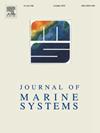Highly variable bottom water oxygen concentration in the shallow Arkona Basin (Baltic Sea)
IF 2.5
3区 地球科学
Q2 GEOSCIENCES, MULTIDISCIPLINARY
引用次数: 0
Abstract
Shallow western Baltic Sea waters show seasonal low oxygen concentrations in bottom waters from summer into early autumn. A record of hourly oxygen measured from 2012 to 2017 at a platform in the central Arkona Basin ascertained important developments of distinct short-term variability in bottom water oxygen concentration. Analysis of these years indicated that severe hypoxia of 0–2 mg L−1 occurred in July with a duration between 0 and 10 h, in August between 0 and 61 h and in September again between 0 and 10 h. Using 4 mg L−1 as the threshold, the ranking of the respective years from longest to shortest duration in hypoxic events showed 2012 (982 h) as the worst, followed by 2016 (854 h), 2013 (769 h), 2014 (659 h) and 2015 (351 h). The clear improvement in 2015 was caused by a Major Baltic Inflow that ventilated the system. Interpreting the drivers of short term hypoxia from the in situ measurements alone was difficult, as adequately resolved biogeochemical parameters were not measured. However, coincident three dimensional high resolution coupled hydrographic-biogeochemical modelling, reproduced the oxygen concentrations at the platform, and additionally revealed considerable spatial variability in the oxygen distribution in the area and its causes. Microbial degradation of organic matter in bottom waters was found to be the major oxygen consumption process with nitrification also contributing in some years. Recovery from seasonal periods of hypoxia is linked to the break-up of the seasonal thermocline or is caused by lateral transport of differently preformed oxygenated waters. The study demonstrates the utility of combining high resolution in situ observations with coincident biogeochemical modelling, as a powerful, integrated tool for monitoring and understanding drivers of short-term seasonal hypoxia.
波罗的海浅海Arkona盆地底部氧气浓度变化很大
从夏季到初秋,波罗的海西部浅海海底的氧浓度呈季节性低。2012年至2017年,在Arkona盆地中部的一个平台上测量的每小时氧气记录确定了底部水氧气浓度明显的短期变化的重要发展。这些年来的分析表明,严重缺氧的0 - 2毫克L−1与0之间的持续时间和发生在7月10 h,介于0和61 h和8月9月再次介于0和10 h。使用4毫克L−1作为阈值,相应的年的排名从2012年缺氧事件显示最短持续时间最长(982 h)最严重,其次是2016(854小时),2013(769小时),2014 (659 h)和2015 (351 h)。2015年的明显改善是由于波罗的海的主要流入给系统通风。由于没有测量到充分解决的生物地球化学参数,仅从原位测量来解释短期缺氧的驱动因素是困难的。然而,三维高分辨率水文-生物地球化学耦合模拟再现了台地的氧浓度,并揭示了该地区氧分布的空间变异性及其原因。海底有机物的微生物降解被发现是主要的耗氧过程,硝化作用在某些年份也有贡献。季节性缺氧期的恢复与季节性温跃层的破裂有关,或者是由不同预形成的含氧水的侧向输送引起的。该研究展示了高分辨率原位观测与同步生物地球化学模拟相结合的实用性,作为监测和理解短期季节性缺氧驱动因素的强大综合工具。
本文章由计算机程序翻译,如有差异,请以英文原文为准。
求助全文
约1分钟内获得全文
求助全文
来源期刊

Journal of Marine Systems
地学-地球科学综合
CiteScore
6.20
自引率
3.60%
发文量
81
审稿时长
6 months
期刊介绍:
The Journal of Marine Systems provides a medium for interdisciplinary exchange between physical, chemical and biological oceanographers and marine geologists. The journal welcomes original research papers and review articles. Preference will be given to interdisciplinary approaches to marine systems.
 求助内容:
求助内容: 应助结果提醒方式:
应助结果提醒方式:


